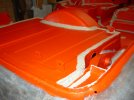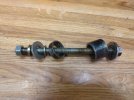greenbeam
Platinum Level Sponsor
Hi all,
Is there a tried and proven method to remove the rear spring bush in the chassis on series 3-5 Alpines?
I've searched the forums and found the tales of woe, but not seen a good how-to on the topic. Even the ever-helpful Sunbeam Alpine Channel on YouTube only tackles the bushes in the springs, not the ones in the chassis.
I have fuel tanks and lines in the car, so the method of using a naked flame isn't really an appealing option.
I've seen one suggestion to drill out the rubber then use a saw to cut the outer tube, but even then the poster mangled the new bush trying to fit it.
I'm sure there are plenty of people that have done this job.
Thanks,
Paul.
Is there a tried and proven method to remove the rear spring bush in the chassis on series 3-5 Alpines?
I've searched the forums and found the tales of woe, but not seen a good how-to on the topic. Even the ever-helpful Sunbeam Alpine Channel on YouTube only tackles the bushes in the springs, not the ones in the chassis.
I have fuel tanks and lines in the car, so the method of using a naked flame isn't really an appealing option.
I've seen one suggestion to drill out the rubber then use a saw to cut the outer tube, but even then the poster mangled the new bush trying to fit it.
I'm sure there are plenty of people that have done this job.
Thanks,
Paul.


